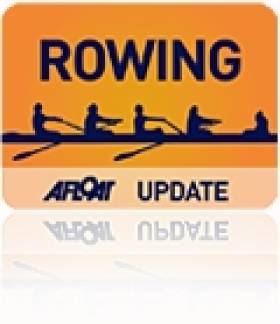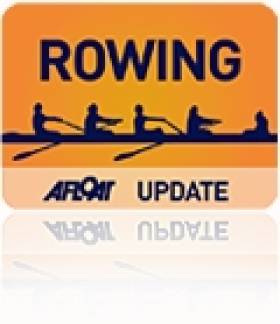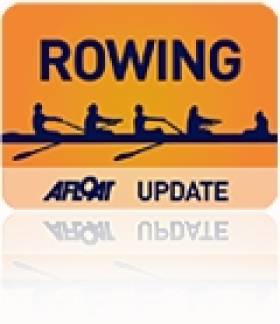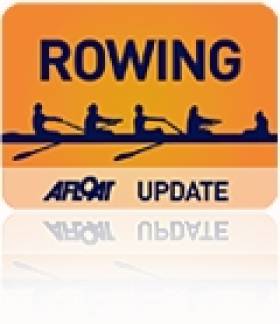Displaying items by tag: Kenny
Lightweight Four Emerge from Ireland Trial
#ROWING: A lightweight men’s four of Shane O’Driscoll, Anthony English, Mark O’Donovan and Niall Kenny impressed the selectors at the Ireland trial at the National Rowing Centre sufficiently to become the nominated crew to train in advance of the final trial in March. Sinéad Jennings and Emma Desmond, who are both injured, were missing from the trial for the lightweight women’s double sculls. The matrix for the available candidates ranked Claire Lambe and Denise Walshe as the fastest crew. Paul and Gary O’Donovan are the nominated men’s lightweight double for the March Trials.
Ireland Trial, National Rowing Centre, Cork (Selected Results; ranked on per centage of projected World Championship gold medal winning time)
Men
Four, Under-23 Double and U-23 Lightweight Double: 1 E Rowan, S McKeown (heavyweight double) 7:11.86 (82.4), 2 Coughlan, Deere, Crowley Meehan (four) 6:46.77 (82.4), 3 F McCarthy, M Ryan (lm double) 7:27.35 (80.9).
Sculling and Lightweight Four: 1 G O’Donovan, P O’Donovan (lightweight double) 6:55.94 (87.0), 2 N Kenny, M O’Donovan, A English, S O’Driscoll (light four) 6:42.50 (84.5), 3 J Keohane, P Doyle (heavy double) 7:07.0 (83.2).
Single Sculls: 1 J Ryan (Lightweight) 7:49.42 (84.8 per cent), 2 S Toland 7:59.6 (lwt, 83.0) 3 M Rowan (heavyweight) 7:51.8 (82.7).
Women
Single/Double Sculls, heavyweight – Race One: 1 L Dilleen 8:03.21 (88.0), 2 L Kennedy 8:21.14 (84.8), 3 Dineen/O’Brien 8:06.17 (80.6). Race Two: 1 O Finnegan 8:41.3 (81.5), 2 A Keogh 8:49.40 (80.3), 3 O Forde 9:00.18 (78.7).
Lightweight Double Matrix: 1 D Walsh, C Lambe 7:36.38 (88.1), 2 S McCrohan, Sarah Dolan 7:43.12 (86.8), 3 R Morris, Sarah Dolan 7:56.55 (84.4).
Tenth Places for Two Ireland Crews at World Rowing Championships
#ROWING: Ireland’s men’s lightweight pair finished fourth in their B Final, 10th overall, at the World Rowing Championships in Amsterdam today. China won in a fast time in tailwind conditions, with Bulgaria and the Netherlands battling each other and finishing second and third. Ireland’s Niall Kenny and Mark O’Donovan were fifth through the middle stages but won their own battle with Austria to take a clear fourth.
The women’s four of Marie O'Neill, Emily Tormey, Aifric Keogh and Barbara O'Brien were fourth in their B Final, behind the Netherlands, who won impressively from Italy, with Germany third.
World Rowing Championships, Amsterdam, Day Six (Irish interest, selected results)
Men
Lightweight Pair – B Final (Places 7 to 12): 1 China (Zhenwei Hou, Fangbing Zhang) 6:28.29, 2 Bulgaria 6:30.40, 3 Netherlands 6:31.01, 4 Ireland (M O’Donovan, N Kenny) 6:34.06, 5 Austria 6:37.65, 6 Chile 6:43.01.
Women
Four – B Final (Places 7 to 10): 1 Netherlands 6:28.95, 2 Italy 6:35.51, 3 Germany 6:37.90, 4 Ireland (M O’Neill, E Tormey, A Keogh, B O’Brien) 6:43.62.
Lightweight Double Sculls – C Final (Places 13 to 18): 1 Russia (D Stepochkina, O Arkadova) 6:58.21, 2 Ireland (C Lambe, D Walsh) 7:00.11, 3 Denmark 7:03.49, 4 Switzerland 7:03.51, 5 Belarus 7:09.08, 6 Greece 7:14.20.
O'Donovan Accelerates Into A Final at World Rowing Championships
#ROWING: Paul O’Donovan gave Ireland its first A Final place at the World Rowing Championships in Amsterdam today with a stirring performance which yielded second place in the lightweight single sculls semi-final. The UCD man lagged the field in the early stages; he was sixth at 500 metres as Zhao Jingbin of China and Marcello Miani of Italy commanded the race. By halfway O’Donovan was marginally in third place, but still over three seconds behind the leaders. As Miani moved clear in the final 1,000 metres, O’Donovan chased down and passed the Chinese. In a close finish, O’Donovan and Perry Ward of Australia took second and third, with Zhao Jingbin pushed into fourth and the B Final.
The Ireland lightweight men’s pair of Mark O’Donovan and Niall Kenny finished sixth in their semi-final and must settle for a B Final place. This was an exciting and fast race where all the boats were in with a chance of qualification until the very final stages, Switzerland, France and Australia took the A Final spots.
World Rowing Championships, Day Five (Irish interest; selected results)
Men
Lightweight Pair – A/B Semi-Final One (First Three to A Final; rest to B Final): 1 Switzerland (S Niepmann, L Tramer) 6:38.67, 2 France (A Mouterde, T Baroukh) 6:41.22, 3 Australia (A Foot, D Purcell) 6:42.39; 4 Bulgaria 6:44.00, 5 Netherlands 6:45.00, 6 Ireland (M O’Donovan, N Kenny) 6:46.60.
Lightweight Single Scull – A/B Semi-Final One (First Three to A Final; rest to B Final): 1 Italy (M Miani) 7:02.00, 2 Ireland (P O’Donovan) 7:03.59, 3 Australia (P Ward) 7:04.10; 4 China 7:04.99, 5 Denmark 7:08.21, 6 Hungary 7:15.08.
Women
Pair – A/B Semi-Final Two (First Three to A Final; rest to B Final): 1 United States (M Kalmoe, K Simmonds) 7:16.35, 2 New Zealand (L Trappitt, R Scown) 7:22.12, 3 Australia (C Sutherland, L Stephan) 7:30.02; 4 Serbia 7:34.92, 5 Ireland (L Kennedy, L Dilleen) 7:35.18, 6 Czech Republic 7:45.68.
Lightweight Double Sculls - C/D Semi-Final (First Three to C Final; rest to D Final): 1 Denmark 7:25.98, 2 Ireland (C Lambe, D Walsh) 7:26.35, 3 Russia 7:26.65; 4 Argentina 7:27.24.
Superb Win For Kenny and O'Donovan over World Rowing Champions
#ROWING: The Ireland lightweight pair of Niall Kenny and Mark O’Donovan caused a major upset on the second day of the World Rowing Championships in Amsterdam today. The new crew at international level won their heat, beating World and European champions Switzerland. The Swiss set a blistering early pace and drew well clear, but the Irish had by far the better second 1,000 metres. They caught and passed the Swiss, who could not meet the challenge and actually stopped before getting going again, allowing China to take the second qualification spot.
World Rowing Championships, Amsterdam, Day Two (Selected Results, Irish interest)
Men
Lightweight Pair – Heat Two (First Two to A/B Semi-Finals; rest to Repechage): 1 Ireland (M O’Donovan, N Kenny) 6:53.54, 2 China (Zhenwei Hou, Fanbing Zhang) 6:54.57; 3 Switzerland 7:03.74, 4 Australia 7:10.31, 5 Bulgaria 7:13.05, 6 Austria 7:19.39.
#ROWING: The men’s junior coxed four was the standout race of the morning session at the Irish Rowing Championships at the National Rowing Centre in Cork today. It took a photo finish to confirm Cork Boat Club’s win over Presentation, with Portora also disputing the lead right to the last 50 metres.
Cork Boat Club also took the women’s junior single sculls title through Oisin Forde, who won a fine battle with Jasmine English of Belfast Boat Club. Forde is from Torrevieja in Spain and with her sister Dervla, who was third, will represent Ireland at the Coupe de la Jeunesse next month.
The men’s senior pair final gave Mark O’Donovan and Niall Kenny of UCD a chance to show why they are in the frame to represent Ireland at the World Championships this year, while a former international Fiola Foley partnered a current one, Monika Dukarska to win the women’s intermediate doubles title.
Irish Rowing Championships, National Rowing Centre, Cork (Selected Results; Finals)
Men
Eight – Intermediate: 1 Trinity 5:46.25, 2 NUIG 5:50.28, 3 UCD 5:56.96.
Four, coxed – Junior: 1 Cork BC 6:35.99, 2 Presentation 6:36.22, 3 Portora 6:38.08.
Pair – Senior: 1 UCD (M O’Donovan, N Kenny) 6:46.05, 2 NUIG 6:49.95, 3 Commercial B 7:00.16.
Sculling
Single: Lee (D O’Sullivan) 7:31.80, 2 St Michael’s (P O’Connor) 7:36.24, 3 Belfast BC (A Murray) 7:39.44.
Women
Eight – Novice: 1 Queen’s 7:19.74, 2 Trinity 7:55.75.
Sculling, Double – Intermediate: 1 Killorglin (F Foley, M Dukarska) 7:17.17, 2 Commercial 7:20.83, 3 Skibbereen 7:39.99.
Single – Junior: 1 Cork BC (O Forde) 8:06.14, 2 Belfast BC (J English) 8:07.11, 3 Commercial B 7:00.16.
Fine Start by Ireland at European Rowing Championships
# ROWING: Ireland had a good start at the European Rowing Championships in Seville today. Claire Lambe nailed the second place she needed to qualify directly for the A Final of the lightweight single sculls and Sanita Puspure qualified for her semi-final of the single sculls by taking the third of three qualification places.
Ireland’s two other crews face into repechages later today. Niall Kenny and Justin Ryan took third in a heat of the lightweight double sculls won by Italy, who took the one semi-final place on offer, repelling a challenge by Austria. Ireland won a mini-battle with Bulgaria for third.
John Keohane finished fifth in his heat of the single sculls. Germany’s Marcel Hacker had his expected win, with Mindaugas Griskonis of Lithuania taking the second qualification place. Keohane, who is new to this level, held off Russian Denis Kleshnev, who finished sixth.
European Rowing Championships, Seville – Day One (Irish interest)
Men
Lightweight Double Sculls – Heat Four (One Directly to A/B Semi-Finals; rest to Repechages): 1 Italy (A Micheletti, P Ruta) 6:39.92; 2 Austria 6:44.49, 3 Ireland (N Kenny, J Ryan) 6:47.43, 4 Bulgaria 6:48.89, 5 Czech Republic 6:51.76.
Single Sculls – Heat One (First Two Directly to A/B Semi-Finals; rest to Repechages): 1 Germany (M Hacker) 7:03.91, 2 Lithuania (M Griskonis) 7:08.15; 3 Italy 7:19.44, 4 Greece 7:22.19, 5 Ireland (J Keohane) 7:25.67, 6 Russia 7:27.89.
Women
Single Sculls – Heat One (First Three to A/B Semi-Finals; rest to Repechage): 1 Ukraine (N Dovgodko) 8:04.02, 2 Norway (T Gjoertz) 8:04.65, 3 Ireland (S Puspure) 8:09.24; 4 Bulgaria 8:18.54, 5 Armenia 9:41.08.
Lightweight Single Sculls – Heat One (First Two Directly to A/B Semi-Finals; rest to Repechage): 1 Austria (M Tauper-Traer) 7:25.35, 2 Ireland (C Lambe) 7:58.09; 3 Czech Republic 8:06.09, 4 France 8:09.57, 6 Cyprus 8:10.61.
Kenny and Jacques Fast in the Rain at Newry Rowing Trial
# ROWING: Niall Kenny was the fastest man on the water at the Rowing Ireland National Assessments in Newry today. The 23 year old lightweight clocked 19 minutes 15 seconds for the five kilometres in the incessant rain. It was a good day for Galway competitors as the fastest crew was the heavyweight men’s pair of Fionnan McQuillan-Tolan and Sean O’Connor. Kenny was ranked as having hit 86.6 per cent of the projected world best time for his grade, but junior single sculler Bridget Jacques performed best of all on this rating, with a mark of 87.8 per cent. She was the third fastest woman after senior heavyweights Sanita Puspure and Monika Dukarska.
| Rowing Ireland |
|---|
| Newry 5km Time Trial; 10th February 2013 |
| Results - OVERALL |
| Category Crew Final Time %age |
| BHM2- Fionnan Mcquillan-Tolan / Sean O'Connor (St.Josephs RC / NUIGBC) 18:58.1 83.0% |
| LM1x Niall Kenny (Grainne Mhaol RC) 19:15.0 86.6% |
| LM1x Justin Ryan (Skibbereen RC) 19:17.0 86.4% |
| BLM1x Shane O'Driscoll (CIT RC) 19:37.0 87.1% |
| JM2- Kevin Fallon / jack smyth (St.Josephs RC / St.Josephs RC) 19:46.2 83.2% |
| BHM2- Adam Boreham / Matthew Wray (Belfast BC / Bann RC) 19:49.2 79.5% |
| BHM1x Johnathan Mitchell (Belfast BC) 19:51.5 83.5% |
| JM2- David Keohane / Brian Keohane (Presentation College RC / Presentation College RC) 19:53.6 82.7% |
| BLM1x Gary O'Donovan (CIT RC) 19:57.0 85.6% |
| JM1x Andy Harrington (Shandon B.C.) 20:01.0 86.2% |
| JM2- Aidan Kinneen / James Egan (St.Josephs RC / St.Josephs RC) 20:10.1 81.6% |
| BLM1x Paul O'Donovan (UCDBC) 20:11.0 84.6% |
| BLM1x Alan Prendergast (Clonmel RC) 20:12.1 84.6% |
| HM1x David Neale (UCDBC) 20:20.7 80.3% |
| JM1x Conor Carmody (Shannon RC) 20:24.7 84.5% |
| BLM1x Aodhan Burns (Skibbereen RC) 20:25.2 83.7% |
| JM1x David O Malley (St Michaels RC) 20:32.7 84.0% |
| JM1x Jack Casey (Shandon B.C.) 20:34.4 83.8% |
| JM1x Paddy Hegarty (Skibbereen RC) 20:35.9 83.7% |
| JM1x John Mitchel (Lee RC) 20:39.7 83.5% |
| HW1x Sanita Puspure (Old Collegians BC) 20:45.7 85.3% |
| JM1x Gareth McKillen (RBAIRC) 20:50.9 82.7% |
| JM1x Evan Stone (Lee RC) 20:51.2 82.7% |
| JM1x william yeomans (Commercial RC) 20:52.4 82.6% |
| BLM1x Eoghan O'Connor (Castleconnell Boat Club) 20:55.0 81.7% |
| JM1x Daniel Buckley (Lee RC) 20:55.0 82.5% |
| HW1x Monika Dukarska (Killorglin RC) 20:55.2 84.6% |
| JM2- Colin Finnerty / Jack Silke (St.Josephs RC / St.Josephs RC) 21:03.0 78.2% |
| JM1x Stephen Murphy (Cork BC) 21:04.7 81.8% |
| JM1x Eoghan Whittle (Castleconnell Boat Club) 21:05.2 81.8% |
| JM1x Sam Keogh (Lee RC) 21:07.5 81.7% |
| JM1x Rory O Sullivan (Lee RC) 21:07.8 81.6% |
| JM1x Neil McCarthy (Cork BC) 21:18.8 80.9% |
| JM1x Kevin Keohane (Presentation College RC) 21:22.7 80.7% |
| JM1x Matthew Ryan (Skibbereen RC) 21:28.2 80.3% |
| JM1x Karl Anderson (Portora BC) 21:29.7 80.3% |
| JM1x James Blackwell (Shannon RC) 21:29.9 80.2% |
| JW1x Bridget Jacques (Belfast BC) 21:32.4 87.8% |
| JM1x Ewan Murry (Portora BC) 21:32.7 80.1% |
| JM1x patrick munnelly (Athlone BC) 21:35.9 79.9% |
| BLM1x Nathan O'Reilly (University of Surrey) 21:36.7 79.0% |
| JM1x Evan Despard (St Michaels RC) 21:40.2 79.6% |
| JM1x Christopher Laffey (Garda RC) 21:47.8 79.1% |
| BLW1x Denise Walsh (Skibbereen RC) 21:51.8 85.9% |
| JW1x Hilary Shinnick (Fermoy RC) 21:52.5 86.5% |
| BLW1x Sinead Dolan (DULBC) 21:56.3 85.7% |
| JM1x Charlie Murray (Cork BC) 21:57.8 78.5% |
| JM1x Alex Chadfield (Clonmel RC) 21:58.6 78.5% |
| JM1x Thomas Cregan (Presentation College RC) 22:08.9 77.9% |
| JM1x Andrew GOFF (Waterford BC) 22:12.3 77.7% |
| JM1x Ewan Gallagher (Athlunkard BC) 22:15.4 77.5% |
| JM1x Kevin Hogan (Colaiste Chiarain RC) 22:18.9 77.3% |
| BLW1x Sally O'Brien (DULBC) 22:19.0 84.2% |
| JM1x Eoghan Fogarty (Neptune RC) 22:19.2 77.3% |
| JW1x Jasmin English (Belfast BC) 22:19.7 84.7% |
| JW1x Fiona Murtagh (Galway RC) 22:31.0 84.0% |
| JM1x Ger McNamara (Athlunkard BC) 22:37.5 76.2% |
| JM1x Aidan Murray 22:38.1 76.2% |
| LW1x Sarah Dolan (Commercial RC) 22:40.1 80.9% |
| JW1x Claire Beechinor (Cork BC) 22:46.6 83.1% |
| JW1x Phoebe Mulligan (Portora BC) 22:49.0 82.9% |
| JM1x Mark Breen (Lee RC) 22:52.9 75.4% |
| JW1x Leonie Hamel (Cork BC) 22:59.5 82.3% |
| JM1x Mike O'HANLON (Waterford BC) 23:12.0 74.4% |
| JM2- Eoghan Walls-Tuite / Kai McGlacken (Colaiste Iognaid RC / Colaiste Iognaid RC) 23:12.4 70.9% |
| JW1x Zoe Hyde (Killorglin RC) 23:17.2 81.2% |
| HM1x Colm Keenan (Molesey BC) 23:19.9 70.0% |
| JW1x Megan McClaughlin (Cork BC) 23:21.6 81.0% |
| JW1x Lauren McHugh (Shannon RC) 23:22.3 80.9% |
| JW1x Kara O'Connor (Muckross RC) 23:22.9 80.9% |
| JM1x Philip McCullough (CAIBC) 23:23.6 73.7% |
| JW1x aisling Rodger (Commercial RC) 23:26.9 80.7% |
| JW1x Eimear Lambe (Commercial RC) 23:31.1 80.4% |
| JW1x Erin Barry (Bann RC) 23:35.1 80.2% |
| JW1x Ruth Gilligan (Shannon RC) 23:37.1 80.1% |
| JW1x Kirsty Turner (Belfast BC) 23:43.9 79.7% |
| JW1x Sarah Murphy (St Michaels RC) 23:59.8 78.8% |
| JW2- Clodagh Scannell / Daisy Callanan (Shandon B.C.) 24:02.9 75.5% |
| JW2- Elizabeth Clarke / Chloe Finlayson (Portora BC / Portora BC) 24:30.2 74.1% |
| JW1x Erin Coll (Shannon RC) 24:45.6 76.4% |
| JW1x Megan Blackburne (Fermoy RC) 24:49.7 76.2% |
| BLM1x Andrew Bell (UCDBC) NTT |
Galway's Kenny In Semi-Finals at World University Rowing Championships
# ROWING: Niall Kenny won his repechage to qualify for tomorrow’s semi-finals of the lightweight single sculls at the World University Championships in Kazan in Russia. The 24-year-old Galway man had finished last in a difficult heat earlier, but he led through all four quarters of the semi-final, beating Rusian Momot of the Ukraine into second. Estonia’s Tamor Bakhoff took the third semi-final place.
World University Rowing Championships, Kazan, Russia – Day One (Irish interest)
Men
Four – Heat Two (First Two to A Final; rest to Repechage): 1 Netherlands 6:08,18, 2 Germany 6:08.22; 3 Italy 6:16.97, 4 Ireland (E Mullarkey, S O’Connor, S O’Driscoll, T Lynam) 6:24.25.
Lightweight Single Sculls – Heat Two (First Three to A/B Semi-Final; rest to Repechage): 1 Switzerland 7:07.60, 2 Poland 7:08.95, 3 Italy 7:09.48; 4 Ireland (N Kenny) 7:29.71. Repechage (Threee to Semi-Finals; rest to C Final): 1 Ireland (Kenny) 7:48.29, 2 Ukraine 7:50.64, 3 Estonia 8:20.69; 4 Malaysia 8:29.94.
Women
Four – Heat Two (Winner to A Final, rest to Repechage): 1 Russia 6:51.90; 2 Poland 7:04.19, 3 Ireland (A Greene, E Kerrigan, H Lavery, C McIlwaine) 7:17.07.
Lightweight Single Sculls – Heat Two (First Two to A Final, rest to Repechage): 1 Ireland (C Lambe) 7:53.86, 2 New Zealand (L Tester) 7:59.70; 3 Czech Republic 8:02.39, 4 Mexico 8:27.96, 5 Italy 8:40.06.





































































